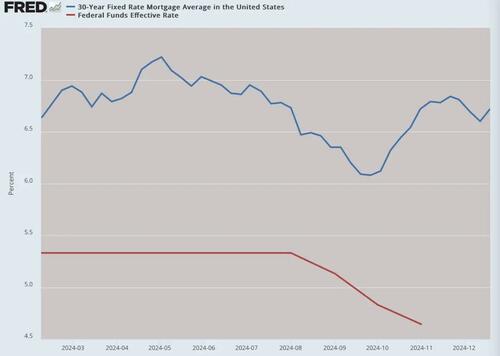Authored by Jeffrey Tucker via The Epoch Times,
Following World War II, a key focus for U.S. policymakers was to promote homeownership for a wide range of citizens. This initiative was largely successful, with many families enjoying comfortable homes across the United States, supported by stable employment and the iconic image of prosperity epitomized by one income, two cars, and the American dream advertised worldwide.
Television shows of the time showcased this ideal lifestyle.
Fast forward to the present day, and that dream is shattered, as homeownership is out of reach for many, even with two incomes. Current trends point to soaring prices that appear more like inflation than a bubble, with little hope for a decrease in prices. Existing homeowners, naturally, prefer to avoid price declines at all costs.
Today, taxes and insurance costs have climbed to match mortgage payments, meaning that the overall expenditure over 30 years could be four times higher than the sticker price, as reported by The Wall Street Journal.
Many individuals are questioning the rationale behind such a situation, exploring alternative ways to utilize liquid assets to generate income rather than channeling them into homeownership.
In recent months, various solutions have been proposed to address this issue, but none seem promising.
Some proposals may exacerbate the problem.
Firstly, there are suggestions for increased Federal Reserve interventions. It’s important to note that the Fed can only influence one rate—the rate charged to member banks. This rate can impact other rates along the yield curve structure, but the outcomes are not always predictable. In some cases, it may lead to a steeper curve, resulting in lower short-term rates combined with higher rates, reflecting future expectations.
This is precisely the scenario unfolding currently, with the Fed reducing the federal funds rate while mortgage rates rise.

(Data: Federal Reserve Economic Data (FRED), St. Louis Fed; Chart: Jeffrey A. Tucker)
Lower rates can fuel inflation, potentially driving up housing prices, insurance costs, and property taxes. Therefore, Fed intervention is unlikely to resolve existing issues and may worsen the situation.
Secondly, restrictions on institutions making cash offers for property purchases have been proposed. This aims to address the perceived unfairness when a cash buyer swoops in and outbids a borrower in negotiations. While such occurrences are prevalent, particularly with large financial firms investing heavily in the housing market, implementing restrictions on these transactions raises questions about interfering with property rights.
The impact on housing prices remains unclear, as the method of payment—cash or borrowed—does not inherently affect overall housing prices. Interventions in this area could lead to unintended consequences, potentially reducing rental availability and exacerbating the housing crisis.
Thirdly, suggestions have been made for the federal government to offer special mortgage rates to specific groups, such as families with children or teachers, at rates as low as 3 percent. However, this approach risks subsidizing high-risk borrowers and replicating conditions that precipitated the 2008 housing crisis. It could also drive up demand for housing, putting upward pressure on prices.
Similar concerns apply to proposals for tax write-offs or subsidies for down payments, which would strain the deficit and likely inflate prices to match the subsidy amount.
Fourthly, there is talk of significantly increasing housing supply in underdeveloped areas. Concepts like freedom cities, supported by substantial development subsidies, have been floated by the Trump administration. However, this approach entails additional public expenditure that fails to address the core issue—people’s preference for housing near their workplaces. Constructing large developments in areas lacking essential infrastructure may not yield the desired results, as evidenced by China’s experiences with similar projects.
Fifthly, proposals for public housing and price control have been suggested, both posing significant drawbacks. While the idea of government-provided housing gained traction in the 1930s, subsequent failures in managing such projects have deterred further exploration of this approach. Public housing units in major cities often become blighted areas that residents disdain. Expanding such initiatives is unlikely to garner public support.
In light of the shortcomings of these solutions, what can be done?
Prioritizing the resolution of inflation is crucial, as it drives up insurance costs. Rising prices across repair sectors, including labor expenses, have rendered insurance unaffordable in many regions. This explains the growing popularity of cash purchases, which circumvent the need for extensive insurance coverage. Curbing inflation demands prudent control over money supply, addressing the root cause of escalating insurance costs.
While reducing or abolishing property taxes could alleviate the burden, this falls under the purview of states and localities rather than the federal government. However, many regions face financial constraints that complicate tax adjustments, as lower property taxes could diminish funding for essential services like education and public safety, potentially driving residents away. State-level initiatives like vouchers for private education show promise, albeit indirectly addressing the housing issue.
Regulatory barriers at the federal level have hindered housing development and expansion, imposing onerous constraints on construction projects. Current standards, such as green energy compliance requirements, pose challenges for individuals seeking to build homes. Streamlining regulations in this area is imperative; in my view, defunding the Department of Housing and Urban Development would eliminate unnecessary bureaucracy and redirect resources from large developers.
While these measures offer potential relief, there is no quick fix to revive the universal homeownership vision of the 1950s. The modern era sees a preference among young individuals for rental flexibility over property ownership burdened by substantial liabilities in taxes, interest, and insurance.
Concentrating reform efforts on regulatory burdens, inflation control, and educational alternatives could yield more effective outcomes in addressing the housing dilemma compared to direct market interventions.
The opinions expressed in this article are solely those of the author and do not necessarily reflect the views of The Epoch Times or ZeroHedge.
Loading…

